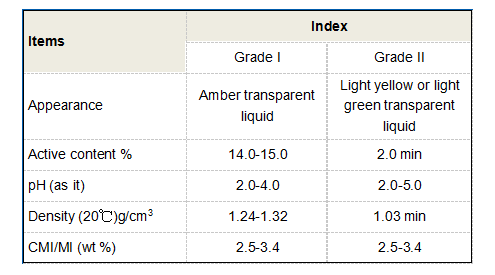Zinc HEDP Environmental Benefits and Industrial Applications in Water Treatment
Understanding Zinc HEDP A Comprehensive Overview
Zinc HEDP, or Zinc Hydroxyethane Diphosphonic Acid, is a vital compound that plays a significant role in various industries, particularly in water treatment and oilfield applications. This article explores the properties, applications, and benefits of Zinc HEDP to provide a comprehensive understanding of this important compound.
What is Zinc HEDP?
Zinc HEDP is a chemical complex formed by the interaction of zinc ions with hydroxyethane diphosphonic acid (HEDP). HEDP itself is a phosphonic acid derivative known for its ability to inhibit the corrosion of metals and to chelate metal ions. When zinc is integrated into the HEDP structure, it enhances the compound's efficacy in many applications, especially regarding its performance in scaling and corrosion inhibition.
Chemical Properties
Zinc HEDP is characterized by its ability to effectively chelate calcium, magnesium, and other divalent ions. This chelation helps in preventing scale formation in various systems, notably in water treatment facilities and cooling towers. With a molecular formula that includes both zinc and phosphorus, Zinc HEDP is water-soluble, making it easy to incorporate into aqueous systems.
Applications of Zinc HEDP
1. Water Treatment One of the primary applications of Zinc HEDP is in the treatment of industrial water systems. It serves as a scale inhibitor, preventing the precipitation of salts that could lead to operational inefficiencies and costly maintenance. By chelating hardness ions, Zinc HEDP ensures that water remains free-flowing and reduces the likelihood of buildup in pipes and equipment.
2. Oil and Gas Industry In the oil and gas sector, Zinc HEDP is employed to protect metal surfaces from corrosion. It is particularly useful in offshore drilling and production environments, where equipment is exposed to both water and corrosive substances. The compound forms a protective layer on metal surfaces, significantly extending the lifespan of equipment and minimizing downtime.
zn hedp 锌hedp

3. Cooling Systems Cooling towers and chillers, which are critical components in industrial processes, often face challenges related to scale and corrosion. Zinc HEDP’s dual function as both a scale inhibitor and corrosion inhibitor makes it an ideal additive for maintaining the efficiency of these systems. Its ability to function effectively even under varying pH and temperature conditions enhances its appeal for this application.
4. Agriculture Zinc, being an essential micronutrient for plant growth, finds its way into agricultural applications where Zinc HEDP is used in fertilizers and soil conditioners. The chelating properties of HEDP ensure that zinc remains available to plants, which is crucial for chlorophyll production and overall plant health.
Benefits of Using Zinc HEDP
1. Enhances Equipment Longevity By effectively reducing scale and corrosion, Zinc HEDP prolongs the life of pipes, boilers, and other equipment, resulting in lower replacement costs and improved operational efficiency.
2. Versatile Application Zinc HEDP can be utilized in various industries, from water treatment to agriculture, showcasing its versatility and broad applicability.
3. Easy to Use The water-soluble nature of Zinc HEDP allows for straightforward incorporation into different systems without the need for complicated processes.
4. Eco-Friendly Alternative Compared to traditional phosphates, Zinc HEDP is considered more environmentally friendly due to its lower toxicity and reduced environmental impact.
Conclusion
Zinc HEDP is a multifunctional compound that offers significant advantages across various industries. Its ability to inhibit scaling and corrosion makes it indispensable in water treatment and oilfield applications, while its role in agriculture underscores its versatility. As industries continue to seek more effective and environmentally friendly solutions, Zinc HEDP is poised to play an increasingly critical role in enhancing operational efficiency and sustainability. Understanding the properties and applications of Zinc HEDP is essential for professionals in relevant fields, helping them make informed decisions about its use in their respective processes.
-
Water Treatment with Flocculant Water TreatmentNewsJun.12,2025
-
Polymaleic AnhydrideNewsJun.12,2025
-
Polyaspartic AcidNewsJun.12,2025
-
Enhance Industrial Processes with IsothiazolinonesNewsJun.12,2025
-
Enhance Industrial Processes with PBTCA SolutionsNewsJun.12,2025
-
Dodecyldimethylbenzylammonium Chloride SolutionsNewsJun.12,2025





